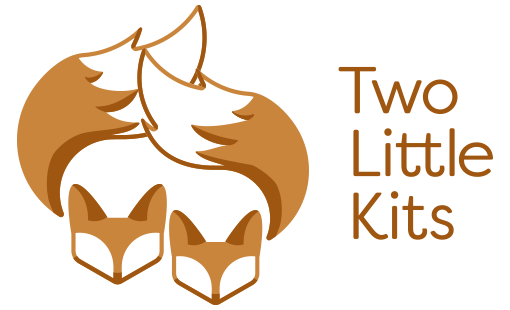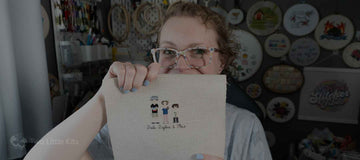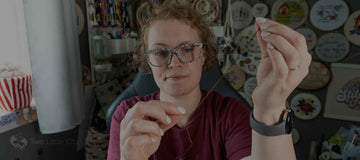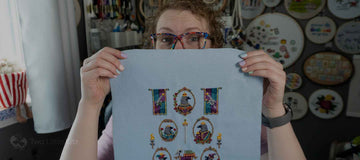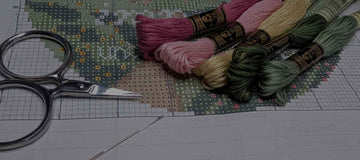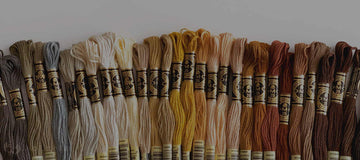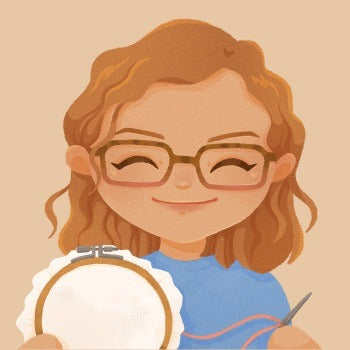
Quick scroll links:
A Beginner's Guide to Cross-Stitch Symbols
If you're new to cross-stitching, reading a cross-stitch pattern can feel like deciphering a secret code. All those tiny symbols on the pattern may look overwhelming, but don't worry! In this guide, I'll walk you through everything you need to know about those little symbols and how they help you create beautiful cross-stitch pieces. By the end, you'll be able to confidently read any pattern key and legend like a pro!
What Are the Symbols On Cross-Stitch Patterns For?
Each of those tiny symbols on your cross-stitch pattern serves one main purpose: they tell you what colour of thread (or “floss”) to use for each section. These symbols correlate directly with the floss colours listed in your pattern's legend or key, helping you know exactly what to stitch where.
How Do Symbols Correspond to Floss Colours?
Every cross-stitch pattern will come with a legend or key, usually on the side or bottom of the page. This key lists each symbol in the pattern, paired with a specific floss colour.
For example, if you see a small “X” symbol in your pattern and find that symbol in the legend, it might tell you to use DMC #310 (black) for those stitches.
Important Note: Symbols vary with each pattern, so it's essential to always check the legend of the pattern you're working on instead of relying on memory from past patterns.

"Floss Daily" cross-stitch kit.
Why Do Symbols Differ Between Patterns?
Cross-stitch designers have creative freedom to choose which symbols they use in their patterns. This means that two different patterns might use completely different sets of symbols even if they use the same colours. Some designers prefer numbers or letters, while others opt for tiny icons or shapes to represent each floss colour. Some use a combination of both!
This is part of what makes each pattern unique, but it also means there's a bit of a learning curve with each new pattern you try. Always rely on the pattern's legend!
Why Do Some Patterns Use Numbers or Letters, While Others Use Graphics?
Designers may use whatever works best for the design's clarity. Some prefer simple letters or numbers for easy readability, while others might use small graphics or shapes that fit the pattern's style. The symbols aren't there for decoration; they're meant to make it easier to read a complex design.
The Meaning Behind These Symbols
The symbols themselves don't have a “universal meaning” like emojis do. Their purpose is purely functional, helping stitchers differentiate between similar colours or sections, especially if the design involves colours that are close in shade. In this way, they're like a map, guiding you to stitch with confidence, knowing each stitch is in the right place.

Step-by-Step Cross-Stitch Symbols Guide for Beginners
Are you still feeling a bit confused by all the symbols on your pattern? Don't worry — you're not alone! Let's go over the essentials step-by-step to make sense of these little icons and get you stitching confidently. Follow along, and you'll be reading any pattern key with ease in no time!
-
Find the Pattern Key or Legend
- Look for the legend or key on your pattern, usually along the side or bottom of the page.
- This key is essential; it tells you what each symbol means and which floss colour to use.
-
Match Symbols with Floss Colours
- Go down the list, matching each symbol in your pattern with the floss colour shown in the key.
- Note the colour number and symbol for each section to avoid mistakes.
-
Organise Your Floss
- Before starting, lay out all the colours you'll be using. Some stitchers even label their floss with symbols to keep things easy!
- Having your floss organised can save time and make the process smoother.
-
Check the Pattern Often
- As you stitch, refer back to your pattern and legend frequently, especially with complex designs or similar colours.
- A quick glance can keep you from stitching the wrong colour, which can be hard to correct later on.
-
Practice with Patience
- Don't rush! Getting familiar with symbols and legends takes a bit of practice, but soon you'll find it becomes second nature.

And that's it!
Now you've got all the basics to understand any cross-stitch pattern key that comes your way. While it might seem tricky at first, remember that each pattern is like a puzzle — each symbol guides you to bring your design to life, one stitch at a time. With a bit of patience and practice, reading these symbols will soon become second nature, adding to the joy and relaxation of cross-stitching.
If you ever feel stuck, don't hesitate to refer back to this guide, and remember, cross-stitching is all about enjoying the process. Happy stitching!
Keep Reading: Tackling Tricky Patterns
If you've ever run into patterns that make you want to pull your hair out (symbols that look too similar, missing legends, awkward page layouts) you'll definitely want to check out my follow-up post: What To Do When Your Cross-Stitch Pattern Is a Hot Mess.
It's packed with tips and workarounds to help you tackle even the trickiest charts so you can get back to stitching with confidence (and joy!). I hope you find it helpful!

Edited: 24th Aug, 2025
Added table of contents & cross-post in the conclusion.
